
The Business of Fashion
Agenda-setting intelligence, analysis and advice for the global fashion community.

Agenda-setting intelligence, analysis and advice for the global fashion community.
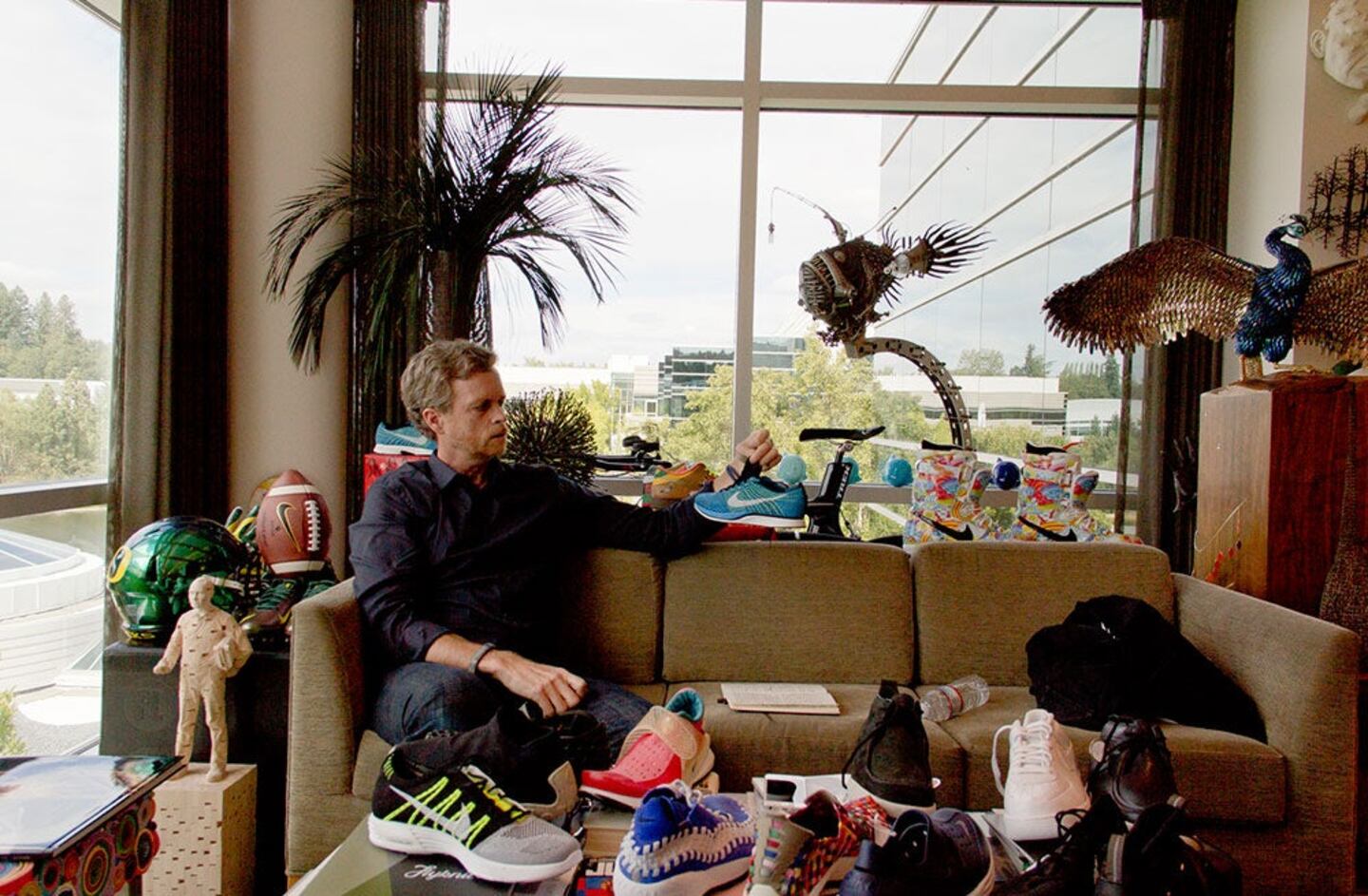
BEAVERTON, United States — How does Nike avoid being the victim of its own success? The answer is HTM, a three-person design collaboration between chief executive Mark Parker, designer Tinker Hatfield, and cultural consultant Hiroshi Fujiwara.
Nike Inc. is a multinational corporation based in Beaverton, Oregon, that employs more than 44,000 individuals in more than 160 countries. Newsweek once said Nike had incited a "new religion of brand consciousness," while The Los Angeles Times claimed that the company was "so much part of everyday culture in so many countries it's frightening." Since Mark Parker became CEO in 2006, Nike's annual revenue is up 60 percent, profits have increased 57 percent, and its market cap has more than doubled. Yet Parker is anything but complacent: "One of my fears is being this big, slow, constipated, bureaucratic company that's happy with its success," he explained.
So how does Nike avoid this, and continue to scale its extreme relevance? The answer is HTM, a three-person design collaboration between designer Tinker Hatfield, creative consultant Hiroshi Fujiwara, and Parker himself, that functions as Nike’s core R&D team. HTM takes its initials from the first names of its members, and was formed in 2002 under the broad mission “to amplify new innovations, reinterpret existing designs, and explore concepts that take the brand to new places.” To date the trio has launched 17 widely varied limited-edition shoes. HTM is an unusual collaboration: it resides within a $26-billion dollar company yet it operates without deadlines or budget constraints and is guided solely by the interests of its three members.
Parker describes HTM as the company's enema, and he believes it has the potential to change everything. On a pristine day in late August I had traveled to Nike’s headquarters to discuss this unique collaboration, its methods, designs, and impact on the company and footwear design.
ADVERTISEMENT
THE PROCESS
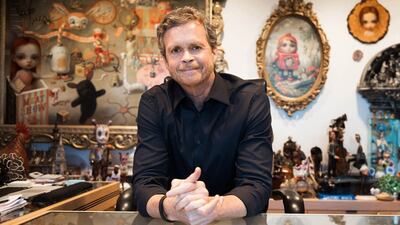
Mark Parker | Photo: Jeff Dey for BoF
“Because everything seems to influence everything else.” Parker was explaining why Nike collaborates with so many diverse talents, including athletes, technologists, designers, and artists. Seated in his corner office, which is a dense and vividly colorful cabinet of curiosities—including an eerie bust of Abraham Lincoln moulded from a life mask, an astronaut’s manual from an Apollo mission, and one of Jimi Hendrix’s guitars—Parker continued, “Even people that have no experience in terms of what we do can come in with a completely fresh mind set.” Seated opposite Parker was Tinker Hatfield, VP of creative concepts, and the man behind many Nike classics, including several Air Jordans and the Air Max 1. The coffee table between us was covered with HTM limited-edition models. Having such an inclination to collect and surround himself with culturally significant bric-a-brac, Parker is not a minimalist, but reductive design is paramount for HTM. “People think you need to add more things to create value,” he says. “It’s more challenging to take things out and only wind up with that which you really need.”
The truth that very few of Nike’s meticulously engineered products will ever be used in the sporting arena isn’t overlooked by its designers. It’s estimated that only 20 percent of the trainers it sells are ever used for any form of exercise, and HTM is astutely aware that much of its success relies on its ability to penetrate popular culture as well as sports. “I have a personal interest in popular culture and the influence of culture on the consumer landscape,” says Parker. “We’re influenced by nature, music, art, technology, and yes, fashion design. Many interesting designs are made by intersecting or blending different influences.”
Hatfield was quick to confirm the rumors that HTM is an informal affair: “It's so casual that it can take its own course, we can be drawing and have stuff on the wall, or we might bring in somebody from sportswear who works on limited editions, and other times we’re sitting around at dinner, at restaurants, which has happened several times.” And Parker elaborated, “That's the beauty of it, there’s not a pressure to fit some schedule, it happens when the impulse is there, and the ideas are flowing.” Fujiwara, who was absent from our discussion in Beaverton, says, “The best way to describe how Mark, Tinker, and I work collectively is through an organic approach.” While the group only meets a few times a year, the lax schedule doesn’t mean it isn’t serious. Their designs are inspired by, make use of, and accelerate Nike’s state-of-the-art manufacturing. The approach also relies on the ninety years of collective experience that exist between the three designers. Asked about the Nike resources at HTM’s disposal, Parker shrugs, “Whatever we need.”
Parker often compares HTM to a musical collaborations, in which individual authorship is jettisoned for the collective whole, as sounds overlap and effect each other in immeasurable ways. While it is difficult, and may not necessarily be productive, to point out the hand of an individual author in an HTM shoe, Parker outlines the division of labor as follows; “Hiroshi comes out of a more style standpoint where as Tinker and I are more on the performance side of design and are less concerned with aesthetics, you can learn a lot from the blending of those different perspectives.”
THE LINEUP
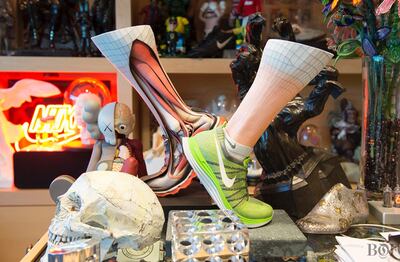
Mark Parker's office space | Photo: Jeff Dey for BoF
ADVERTISEMENT
After his undergraduate studies in Political Science at Penn State University, Parker began his career as a footwear designer in 1979 at a Nike R&D facility in Exeter, New Hampshire. Since then he’s worn many hats at the company, including general manager and vice president of global footwear, finally assuming the role of chief executive officer in 2006. Parker speaks patiently and deliberately, “The mash up, the charettes that we do, informally and formally, is a little bit like jazz improvisation, you riff a little bit here and there, and you get different ideas coming out of it that you wouldn't normally out of some more disciplined process. He has excelled at assembling, nurturing, and leading the kind of unfettered collaboration that has made Nike so progressive in design and successful in business.
Hatfield is at home in Parker’s office, at one point he disappeared behind Parker’s desk in search of an old prototype, jokingly called out, "I'm riffling through your priceless collection, without regard for anything." Parker and Hatfield’s easy-going and modest demeanors belie the fact that these two Nike lifers have played a major hand in transforming the global footwear industry over the last three decades, ushering in one performance driven technology after another, and revolutionising shoe aesthetics in the process.
As an Architecture student at the University of Oregon, Hatfield was coached in track by Nike co-Founder Bill Bowerman. Then, in 1981, he joined Nike as a corporate architect of retail spaces and soon found himself translating his architectural approach to shoe design. The Nike Air Max, one of his early designs, was inspired by a visit he took to Renzo Piano’s Centre Pompidou. More than any building before it, the Centre Pompidou revealed its innards on its façade, and the Air Max 1 in turn exposed its own Air technology along the side of its sole. “The Air Max 1 was a performance shoe but I wanted to bring a storyline that would highlight the technology to people—to help people understand the new AIR technology used in the shoe. That shoe helped us understand how to sell a story and market our products,” Hatfield explains.
Fujiwara spent his late teens and early twenties cross-pollinating the music, fashion, and street cultures of early 1980s Tokyo, London, and New York. Known as the mastermind of Harajuku, Fujiwara has been the backbone to a movement that goes much further than a commercial neighborhood of Tokyo. A protégé of Malcolm McLaren in 80s, Fujiwara became an insurgent innovator of the post-punk and hip-hop cultures in Japan. He helped in the founding of fashion labels Undercover and A Bathing Ape, with Jun Takahashi and Nigo, respectively, while also popularizing brands like Stussy and, more recently, visvim. Fujiwara's sensitivity to subtle changes across the cultural and aesthetic airwaves, which go undetected by most, keeps him at the forefront of a swath of activities in music production, fashion design, and branding, and busy working with clients like Starbucks, Levis, and APC. When asked about how he decides to work with the people he does, Fujiwara explains, "It's just a natural feeling. It always depends on timing. At the moment I feel like doing more with Nike, and HTM is the company's pinnacle project with an important position to introduce opportunity into major places."
While Fujiwara’s work is highly visible, the man is most comfortable behind the scenes. Though he was physcially absent from our discussion, his personality and abilities seemed to linger in the room, perhaps from his last visit to Nike some three weeks prior. “I think he's just a cool dude,” Hatfield stated enthusiastically, to which Parker adds, “Hiroshi's style is very calm and thoughtful. He has a high level of sensitivity, particularly on an aesthetic level.”
THE SITUATION
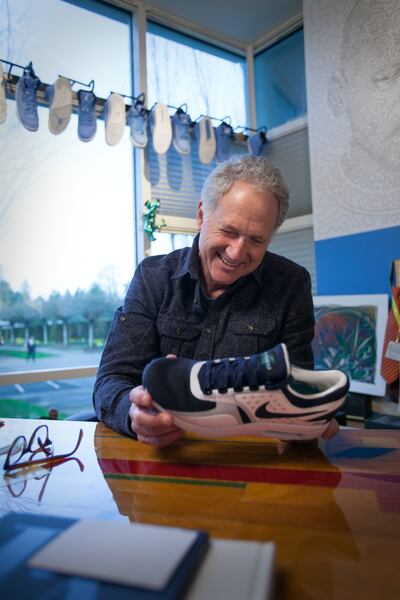
Nike vice president of design and special projects, Tinker Hatfield | Source: Courtesy
HTM is a highly personal project for its members. Parker even stated that “there is a practical value in the impact that HTM can have, but there is also a selfish creative outlet for all of us.” It’s clear that while Nike has reached the heights of corporate scale, design at the company has sustained itself as an intimate endeavor. As CEO, Parker’s involvement in HTM imbues the group’s work with clout and a sense of urgency, and sends a clear message—that design is paramount—across the company. The intimate scale, fast pace of the collaboration, and connection to institutional memory is a design model that allows them to make impactful advancements within a colossal corporation.
ADVERTISEMENT
While the typical Nike sneaker is produced in a volume of 3,000 and distributed globally, HTM models are produced in as few as 60 units and sold at a handful of select shops. As a result there are fewer people involved in each HTM project, and Hatfield is brought back to his roots at Nike; “In the end HTM is awesome because it takes Mark and I both back to a different era when there weren't so many people involved in the decision making process, even for big things. So we get to operate like we did maybe 30 years ago.”
Limited editions have always been central Nike’s culture. In 1971, Nike co-founder Bill Bowerman made the first Nike sneaker in an edition of one. Bowerman made the sole by pouring rubber into a waffle iron, which moulded high-traction and lightweight treads. For the 1989 films Back to the Future and Batman, Nike made custom futuristic shoes for Michael J. Fox and Michael Keaton, respectively. Fox’s shoes hugged his feat with air pressure and not laces, and Keaton’s boots were inspired by Nike cross-training shoes. “In a sense, we've been doing HTM from the beginning, we just didn't call it that,” says Hatfield, who was involved with both film projects.
This flexibility in production is matched by HTM’s informal marketing strategy, which is entirely distinct from Nike’s emotional branding of heroism and athelete endorsements. HTM demonstrates the most composite example of the company’s more surgical and subtle marketing strategies. Writer Gary Warnett explains, “HTM could seem dormant to the outside world for a decade then make a return as if it never left, with no explanation and minimal marketing, which is refreshing today, when everything seems so keen to meet seasonal demand. In that way it's kind of pure —there's a chase and a willful awkwardness to getting product, even though the end result is often very simple and accessible.” HTM’s indecipherable marketing is an important case in the dilemma of how to introduce street cred into the company’s vast size.
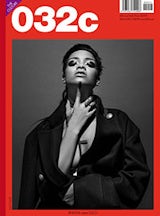 The full version of this article appears in the Winter 2013/2014 issue of 032c, a biannual art and fashion publication based in Berlin. The issue also includes images of pop star Rihanna shot by Inez van Lamsweerde & Vinoodh Matadin; Kristen McMenamy wearing Christian Lacroix's haute couture collection for Elsa Schiaparelli, shot by Juergen Teller; and an in-depth dossier on Pablo Picasso and the small but significant German-Jewish art dealers who embraced his work.
The full version of this article appears in the Winter 2013/2014 issue of 032c, a biannual art and fashion publication based in Berlin. The issue also includes images of pop star Rihanna shot by Inez van Lamsweerde & Vinoodh Matadin; Kristen McMenamy wearing Christian Lacroix's haute couture collection for Elsa Schiaparelli, shot by Juergen Teller; and an in-depth dossier on Pablo Picasso and the small but significant German-Jewish art dealers who embraced his work.From analysis of the global fashion and beauty industries to career and personal advice, BoF’s founder and CEO, Imran Amed, will be answering your questions on Sunday, February 18, 2024 during London Fashion Week.
The State of Fashion 2024 breaks down the 10 themes that will define the industry in the year ahead.
Imran Amed reviews the most important fashion stories of the year and shares his predictions on what this means for the industry in 2024.
After three days of inspiring talks, guests closed out BoF’s gathering for big thinkers with a black tie gala followed by an intimate performance from Rita Ora — guest starring Billy Porter.